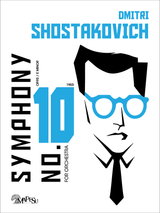
The Symphony No. 8 in C minor, Op. 65, by Dmitri Shostakovich was written in the summer of 1943, and first performed on 4 November of that year by the USSR Symphony Orchestra under Yevgeny Mravinsky, to whom the work is dedicated. It briefly was nicknamed the "Stalingrad Symphony" following the first performance outside the Soviet Union in 1944.
Music critics have ranked it among the composer's finest scores. David Haas has argued that the work falls within the tradition of other C minor "tragedy to triumph" symphonies, such as Beethoven's Fifth, Brahms' First, Bruckner's Eighth, and Mahler's Second, although there is considerable disagreement over the level of optimism present in the final pages. Shostakovich's friend Isaac Glikman called this symphony "his most tragic work". The work, like many of his symphonies, breaks some of the standard conventions of symphonic form and structure. Shostakovich clearly references themes, rhythms and harmonies from his previous symphonies, most notably Symphony No. 5 and Symphony No. 7.
The symphony consists of five movements:
1. Adagio – Allegro non troppo (C minor)
2. Allegretto (D♭ major)
3. Allegro non troppo (E minor) –
4. Largo (G♯ minor) –
5. Allegretto (C major)
- Difficulty:
- Advanced
- Instrumentation:
- 4Fl2dPicc, 2Ob, CA, 2Cl, Bcl, Cl Eb, 3Bsn1dCbsn, 4Hn, 3Tpt, 3Tbn, Tba, Timp, Perc, Strings
- Duration:
- 62 to 70 minutes
- Set of Parts:
- Includes Strings count 5.5.4.4.3
- Extra Strings:
- Only available with the purchase of the Set of Parts






